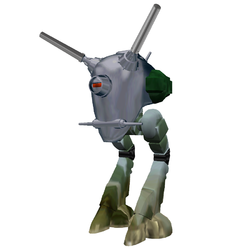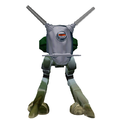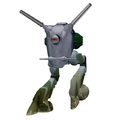Polyrobo
| This article is non-canon. | ||
|---|---|---|
The subject matter of this article does not take place in the "real" Half-Life and Portal universe and is considered non-canon. |

| |
| Polyrobo | |
|---|---|
| General information | |
| Type |
Walking mech |
| Game information | |
| Entity |
monster_polyrobo[1] |
Polyrobo[2] is a robot model used by Valve during the early previews of Half-Life to demonstrate the technical features of the GoldSrc engine.
Overview[edit]
Designed as a large bipedal mech, Polyrobo was primarily meant to show off the engine's skeletal animation system. With a polygon count of over 6,000, an extremely high amount for its time, the model would play a smooth dancing animation on cue, a feat that would not have been possible without the new animation system.[3] The demonstration also featured a metallic chrome surface on the model's head that produced a realistic reflection effect,[4][5][6] a real time shadow cast onto the floor,[5] head movement that could dynamically track the player's movement,[6] and multiple bounding boxes on a single model that allowed more precise targeting.[7]
The model was publicly exhibited at the E3[5][8] and ECTS[6] trade shows in 1997, the Sierra Studios Launch Event in April of 1998,[7] and was part of the alpha demos sent for previewing to publications, including Half-Life version 0.52, where it is present in the map techdemo which was used for the E3 demonstration.[9]
Polyrobo was also mentioned in the August 1997 issue of Next Generation magazine which featured a preview for the game. Identified as a "public domain robot model" and specified that it wouldn't be appearing in the final game, Valve engineer Ken Birdwell remarked in the article that the model was put in as a test to see if it would break the engine, and it ultimately didn't. He also stated that, with its skeletal structure only possessing 20 bones, the memory and processor requirements for animating the model were far less than what was needed by the vertex animation system used in most other contemporary games such as Quake.[4] Following these public demonstrations, the claim that Half-Life would support monsters sporting polygon counts of up to 6,000 was met with skepticism from fans and journalists,[10] and Valve later stated that the Polyrobo demonstration was simply to boast their engine's capabilities[11] as aiming for this level of complexity in-game was unfeasible.[10]
Behind the scenes[edit]
The robot's design was based on the Regult Battle Pod from the anime Super Dimension Fortress Macross.[7] The dancing animation it performs was based on the "Dancing Baby" cha-cha type dance which was a popular Internet phenomenon at the time.
In the Half-Life Alpha, the Polyrobo model contains a walking animation named walk which is never shown off. When it is dancing and walking, the model is meant to play footstep noises using the sounds polyrobo/robo_walk.wav, polyrobo/robo_walk2.wav, and polyrobo/thumpb3.wav. However, these sounds are not included with this build.
In the internal developer notes for Half-Life Alpha version 0.61, which was used at the Sierra Studios Launch Event,[7] a map named polyrobo is listed.[12] The exact contents of this level are unknown as this particular build has never been made public.
Gallery[edit]
See also[edit]
References[edit]
- ↑ Half-Life Alpha
- ↑ Its entity name
- ↑ The Half-Life Interview on Online Gaming Review (July 11, 1997) (archived)
- ↑ 4.0 4.1 Next Generation (August 1997 issue), page 107
- ↑ 5.0 5.1 5.2 Half-Life preview on Online Gaming Review (June 24, 1997) (archived)
- ↑ 6.0 6.1 6.2 ECTS Half-Life preview on Fragile Mortality (September 16, 1997) (archived)
- ↑ 7.0 7.1 7.2 7.3 Half-Life preview on Gamers Extreme (April 1998) (archived)
- ↑ Redwood's E3 1997 Review on Redwood's 3D News (1997) (archived)
- ↑ Half-Life Alpha (version .52) Notes (
Half-Life Readme (in Word 95 format).doc) (September 8, 1997) - ↑ 10.0 10.1 Half-Life 2: Raising the Bar (uncorrected proof), page 36
- ↑ Half-Life Interview on The Gaming Nexus (March 16, 1998) (archived)
- ↑ Half-Life Alpha (version .61) Notes (
Half Life Main v6.doc) (August 26, 1998)







